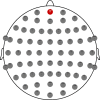Using ERPs to unveil the authenticity evaluation and neural response to online rumors
- PMID: 39732837
- PMCID: PMC11682157
- DOI: 10.1038/s41598-024-82696-x
Using ERPs to unveil the authenticity evaluation and neural response to online rumors
Abstract
The rapid propagation of information in the digital epoch has brought a surge of rumors, creating a significant societal challenge. While prior research has primarily focused on the psychological aspects of rumors-such as the beliefs, behaviors, and persistence they evoke-there has been limited exploration of how rumors are processed in the brain. In this study, we experimented to examine both behavioral responses and EEG data during rumor detection. Participants evaluated the credibility of 80 randomly presented rumors, and only 22% were able to identify false rumors more accurately than by random chance. Our ERP findings reveal that truth judgments elicit stronger negative ERP responses (N400) compared to false judgments, while false judgments are associated with larger positive ERP responses (P2, P3, and LPP). Additionally, we identified gender differences in brain activity related to rumor detection, suggesting distinct cognitive strategies. Men demonstrated greater P2 and enhanced N400 responses, while women exhibited larger P3 and LPP amplitudes. This study is among the first to investigate the neural patterns underlying rumors recognition and to highlight gender disparities in decision-making related to rumors.
Keywords: Credibility; Event related potentials; Online rumors; Social media.
© 2024. The Author(s).
Conflict of interest statement
Declarations. Competing interests: The authors declare no competing interests. Ethics approval and consent to participate: All participants of the study provided written informed consent. All authors disclose no actual or potential conflicts of interest including any financial, personal, or other relationships with other people or organizations that could inappropriately influence (bias) their work. The study was approved by the Ethics Committee of Institute of Neuroscience and Cognitive Psychology of Anhui Polytechnic University (AHPU-SEM-2021-002).
Figures









Similar articles
-
Neural correlates of economic value and valuation context: an event-related potential study.J Neurophysiol. 2018 May 1;119(5):1924-1933. doi: 10.1152/jn.00524.2017. Epub 2018 Feb 14. J Neurophysiol. 2018. PMID: 29442556
-
Event-related potentials reveal task-dependence and inter-individual differences in negation processing during silent listening and explicit truth-value evaluation.Neuroscience. 2014 Sep 26;277:902-10. doi: 10.1016/j.neuroscience.2014.07.043. Epub 2014 Aug 1. Neuroscience. 2014. PMID: 25088913
-
Cognitive disparity in online rumor perception: a group analysis during COVID-19.BMC Public Health. 2024 Nov 5;24(1):3049. doi: 10.1186/s12889-024-20549-y. BMC Public Health. 2024. PMID: 39501216 Free PMC article.
-
Beauty is in the belief of the beholder: cognitive influences on the neural response to facial attractiveness.Soc Cogn Affect Neurosci. 2016 Dec;11(12):1999-2008. doi: 10.1093/scan/nsw115. Epub 2016 Aug 13. Soc Cogn Affect Neurosci. 2016. PMID: 27522090 Free PMC article.
-
Processing children's faces in the parental brain: A meta-analysis of ERP studies.Neurosci Biobehav Rev. 2022 May;136:104604. doi: 10.1016/j.neubiorev.2022.104604. Epub 2022 Mar 10. Neurosci Biobehav Rev. 2022. PMID: 35278598 Review.
References
-
- How to fight an infodemic? The Lancet, February 19th. (2020). https://www.thelancet.com/journals/lancet/article/PIIS0140-6736(20)30461...
-
- Naeem, M. & Ozuem, W. Understanding misinformation and rumors that generated panic buying as a social practice during COVID-19 pandemic: evidence from Twitter, YouTube and focus group interviews. Inform. Technol. People. 35 (7), 2140–2166 (2022).
MeSH terms
Grants and funding
LinkOut - more resources
Full Text Sources

